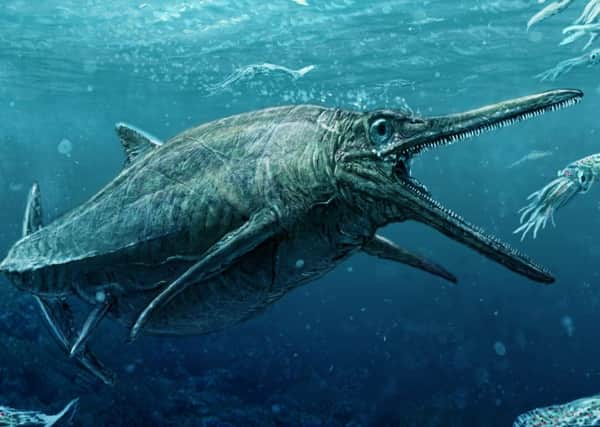Storr Loch Monster skeleton unveiled by scientists
This article contains affiliate links. We may earn a small commission on items purchased through this article, but that does not affect our editorial judgement.


The fossilised remains of the huge dolphin-like creature, known as an ichthyosaur, was discovered on the Isle of Skye in 1966.
The 4m-long reptile lived around 170 million years ago and had a long pointed snout lined with hundreds of jagged teeth that it used to feast on squid and fish.
Advertisement
Hide AdAdvertisement
Hide AdIt has been nicknamed the Storr Lochs Monster, after the area where it was found on Skye’s Trotternish peninsula.
The petrified bones make up the most complete skeleton of a Jurassic marine reptile ever found in Scotland and has been hailed as the “crown jewel” of Scottish fossils.
• READ MORE - Tourist captures Loch Ness Monster on video
The bones were discovered 50 years ago on a beach near the Storr Lochs power station by manager Norrie Gillies, who died in 2011 aged 93.
It had been preserved and stored since then at a special facility run by National Museums Scotland.
But now a new collaboration between the museum, the University of Edinburgh and energy company SSE has allowed the fossil to be extracted from the rock that has encased it for millions of years.
Palaeontologists will carry out detailed analysis of the fossil, which belongs to the extinct family of sea-living reptiles called ichthyosaurs.
They hope studies will provide new insights into the lives of the fearsome beasts and the time when they existed.
The Middle Jurassic period is a part of the planet’s history that has long been shrouded in mystery due to a lack of fossil evidence from the age.
Advertisement
Hide AdAdvertisement
Hide AdSkye is one of the few places in the world where Middle Jurassic fossils can be found.
Dr Steve Brusatte, of the University of Edinburgh’s School of GeoSciences, said: “Ichthyosaurs like the Storr Lochs Monster ruled the waves while dinosaurs thundered across the land.
“Their bones are exceptionally rare in Scotland, which makes this specimen one of the crown jewels of Scottish fossils.
“It’s all thanks to the keen eye of an amateur collector that this remarkable fossil was ever found in the first place, which goes to show that you don’t need an advanced degree to make huge scientific discoveries.”
Skye has been likened to a real-life Jurassic park, attracting fossil hunters from all over the world.
Evidence of dinosaurs and giant reptiles from the Middle Jurassic and other eras have been discovered in various locations on the island.
Earlier this year the Dr Brusatte and his team identified a new species of ichthyosaur from another fossil fragment discovered on the island.
Dinosaur footprints can be seen on a beach at Staffin, and also at low tide near Duntulm Castle in Trotternish.
Advertisement
Hide AdAdvertisement
Hide AdThe museum Staffin also has the world’s smallest dinosaur footprint in its collection.
The earliest turtles known to live in water were also uncovered in southern Skye.
Experts say the new species forms a missing link between ancient terrestrial turtles and their modern-day aquatic descendants.
Once studies are complete, the Storr Lochs monster will go on show at various locations, including SSE’s new visitor centre at Pitlochry Dam.
DOWNLOAD THE SCOTSMAN APP ON ITUNES OR GOOGLE PLAY